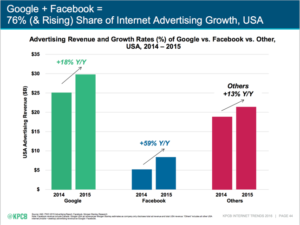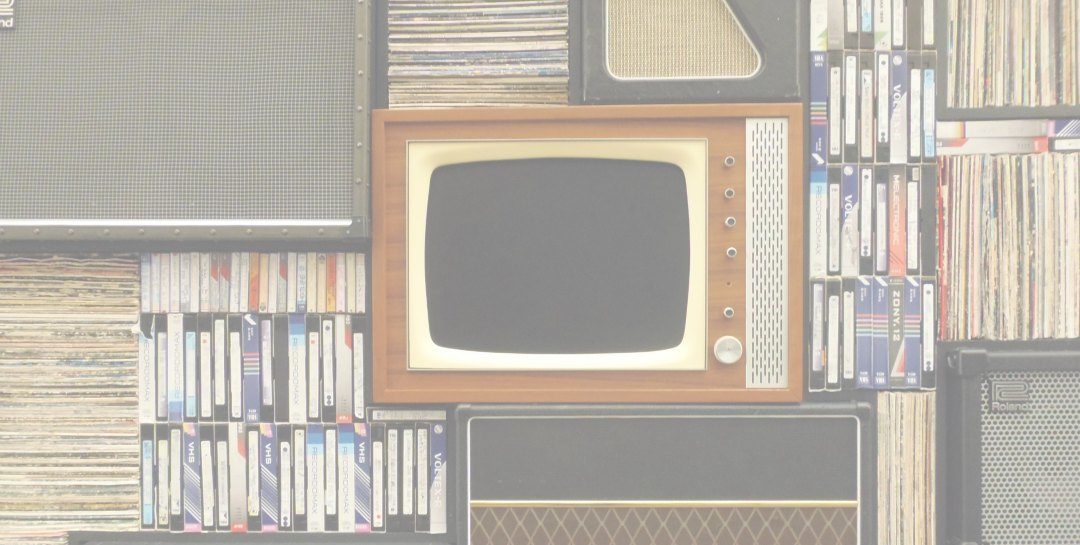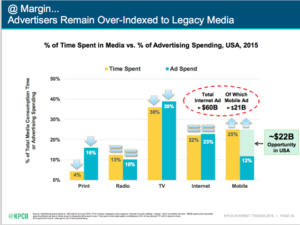It is that time of year when Mary Meeker releases her (21st) annual Internet Trends report . Over the next few weeks I am going to explore some of the key trends so you don’t need to read and digest the 213 pages.
Let’s start in the eye of the storm – media
As with last year TV and print remain over indexed in terms TV ad spend vs. the amount of time spent consuming the media.
While TV still gets the lion share of the money it is moving Meekers report shows a steady decline in TV spend while internet and mobile spend is increasing. Mobile continues to have the biggest potential as time spend exceeds ad spend by 13%.
For broadcasters this shift is an issue, primarily as the world moves from limited inventory (there is only a certain amount of Super Bowl advertising spots) to unlimited online advertising coupled with a significant change in yield (an ad costs less on digital channels than traditional channels). The drop in yield when you move from one medium to another is stark, in the print business there is a saying print dollars, to digital dimes to mobile pennies. Effectively this is saying as you move medium you only attract 10% of the value that you previously did – devastating for a commercial model. Looking at the chart above print print still has a lot of pain ahead of it as it still attracts 16% of the money yet only 4% of the time.
Sorry but there is more bad news for broadcasters? Statistics in the UK showed a decline in household owned televisions for the first time and this trend is expected to go global.
Digital media has captured the attention of the 18-34 year old market that is difficult to reach at best of times. A huge portion of digital media spend is going to video with YouTube (part of Google)gaining from the migration of ad spend from TV. What’s worse is in a study by Nielsen, people are more likely to support the service they grew up with, meaning it is hard to get the youth back to TV or print if they started on YouTube.
YouTube are bidding on streaming TV shows and movies, it does not look good for TV. Already there are suggestions that linear television isn’t even the most-watched platform for traditional television content any more. Netflix’s head of content acquisitions, Ted Sarandos, has suggested that audiences for its original show “Narcos” actually surpassed that of HBO’s “Game of Thrones,” saying: “We’re pleased to take the number two spot, but think it is number one because they don’t measure all the devices.
But maybe there is a short term reprieve? “TV is still the most-penetrated single medium, with 95% of all consumers having access to a TV- unchanged since 2012. Desktops and laptops, meanwhile, increased their reach over the same time period, from 61% to 71%.”
As I mentioned before there is life in the old girl it still earns huge amounts of ad spend relative to time spent watching it, largely due to the perception that it still offers greater reach than other platforms. The good news is in show that upfronts (pre purchased advertising) in the US are up between 7 – 12%, with the launch of the 2015-2016 season, however I wouldn’t conclude that this is an ongoing trend – as the old media adage ‘dollars follow eyeballs….. eventually) will play out.
In my view TV should take the money on offer and aggressively invest it in transformation and feel thankful for a short reprieve.

But let’s dig into this some more next week
What does this mean to me and my brand?:
The advice remains the same as it has been for years
- You need to be where your customers are and engage on a platform they use. As a dangerous sample of one… If you are aiming to catch me, don’t waste your dollars on print or TV.
- You need to understand your customer’s world view and tell authentic, engaging stories to them.
- Demand ROI measures from your media.
- And for the old world media crew: TV and print you still have massive reach your need to tell a better story than digital are, you need to justify your price and define your ROI. This is the story you are competing with is
- Digital is growth, digital is youth, digital can target, digital is personal
- Digital can prove ROI
- Digital has less wastage
- If there is a reprieve in spend as there is predicted in the US – use it to invest it aggressively in the transformatio
Next week we take a look at what this all means for the digital crew.
KS





